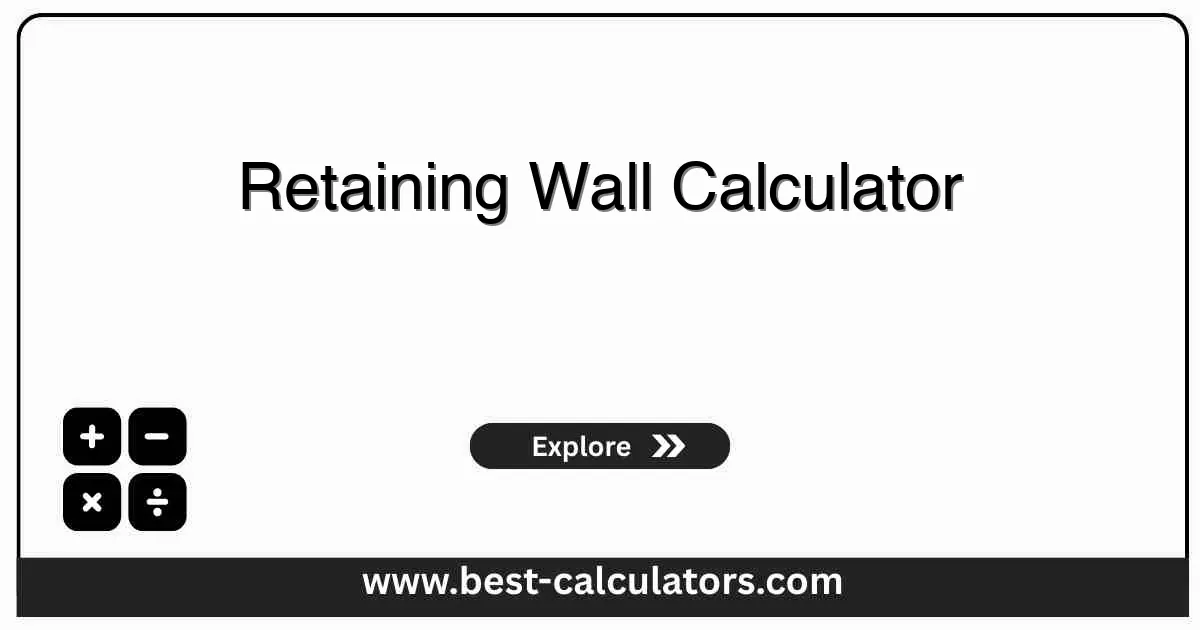Retaining Wall Calculator - Estimate Blocks, Concrete & Backfill
Plan your retaining wall with precise estimates for blocks, concrete volume, gravel base, and backfill using compact, professional-grade calculations.
Retaining Wall Calculator
Results
Calculations assume consistent wall height, rectangular geometry, and typical hollow CMU or segmental blocks. Results are rounded to practical values.
What is a Retaining Wall Calculator?
A retaining wall calculator is a free construction planning tool that helps you estimate the number of blocks, concrete volume, footing/base size, and backfill requirements for gravity or segmental retaining walls. It converts wall dimensions and block sizes into practical material quantities.
This calculator works best for:
- Segmental block walls for gardens, terraces, and landscaping.
- Concrete or CMU walls used as low retaining or support walls.
- DIY planning where you need quick, realistic material estimates.
To estimate the concrete and reinforcement needed for poured retaining walls, use our Concrete Calculator to calculate precise concrete volume for footings, stems, and caps.
For block-based retaining walls with masonry units, explore our Concrete Block Calculator to determine CMU quantities, mortar needs, and wall costs.
To size and estimate supporting slabs, approaches, or paved areas near your retaining wall, use our Paver Calculator to plan patios, walkways, and hardscapes that integrate with the wall.
For drainage and granular base design under and behind your wall, try our Gravel Calculator to estimate crushed stone and drainage aggregate volumes accurately.
To evaluate related structural and ground loading aspects such as snow on supported slabs or roofs nearby, use our Snow Load Calculator to understand design load implications.
How the Retaining Wall Calculator Works
The calculator uses standard geometric formulas and realistic construction assumptions:
Blocks = (Wall Area / Block Face Area) × (1 + Waste%)
Wall Volume = Length × Height × Thickness
Backfill Volume = Length × Height × Backfill Zone
Footing Volume = Length × Footing Depth × Thickness
Where:
- Block face area uses block length × height (inches) converted to ft².
- Wall volume is expressed in yd³ for compatibility with concrete ordering.
- Backfill assumes a vertical drainage/backfill zone behind the wall.
- Waste factors add practical allowances for cutting and placement losses.
Key Concepts Explained
Gravity & Segmental Walls
These walls rely on their own weight and block interlock to resist soil pressure. Accurate block count and proper base are critical.
Footing & Base Support
A compacted crushed-stone base or concrete footing spreads loads and reduces settlement, improving long-term stability.
Drainage & Backfill
Free-draining aggregate and proper outlets reduce hydrostatic pressure—a major cause of retaining wall failure.
Engineering Limits
Walls above ~4 ft or carrying surcharge loads must be engineered using full stability checks (sliding, overturning, bearing).
How to Use This Retaining Wall Calculator
Measure the Wall
Enter total wall length and maximum exposed height in feet for your retaining wall line.
Set Wall Thickness
Use typical values based on block depth or concrete wall thickness to represent wall width.
Define Block Size
Enter block face dimensions in inches (e.g., 16" × 8") to compute block count.
Adjust Costs & Backfill
Input local block and concrete prices plus backfill and waste allowances for realistic budgeting.
Review Material Summary
Use the block, concrete, and backfill volumes to order materials and compare wall options.
Apply Engineering Judgment
For critical walls, treat results as a starting point and consult professionals for final design.
Benefits of Using This Calculator
- • Fast planning: Get an instant snapshot of blocks, concrete, and backfill needed.
- • Cost clarity: Estimate block and concrete costs early to compare design options.
- • Waste control: Built-in allowances reduce the risk of running short on materials.
- • Professional logic: Uses standard geometric relationships familiar to contractors.
Factors That Affect Your Results
1. Wall Height & Type
Taller walls, tiered walls, or cantilevered systems require different design assumptions than small garden walls.
2. Soil & Drainage
Clay, saturated soils, or poor drainage increase lateral pressure and may demand thicker walls or geogrid.
3. Surcharge Loads
Driveways, parking, or foundations near the wall significantly change design forces and material needs.
4. Block System Details
Different block systems have unique batter, core fill, and geogrid requirements; always follow manufacturer data.

Frequently Asked Questions (FAQ)
Q: How do I calculate the volume of a retaining wall?
A: To calculate retaining wall volume, multiply length × height × thickness for each wall segment. Convert all dimensions to the same unit, compute volume in cubic feet or meters, then convert to cubic yards or cubic meters for concrete or backfill estimation.
Q: How many concrete blocks do I need for a retaining wall?
A: Divide the total wall area (length × height) by the face area of one block. For a standard 16" × 8" block, the face area is about 0.89 sq ft. Always add 5-10% extra blocks for cuts, waste, and breakage.
Q: How wide should the base of a retaining wall be?
A: A common guideline is that base width should be at least 50% to 70% of wall height for gravity walls, plus a stable crushed-stone leveling pad. Engineering rules vary by soil, surcharge, wall type, and local codes. Consult a structural professional for critical walls.
Q: How much backfill do I need behind a retaining wall?
A: Typical segmental block walls require a drainage zone of gravel 12–16 inches wide behind the wall plus additional compacted backfill beyond that. Calculate backfill volume using length × backfill thickness × average height.
Q: Can this calculator replace structural engineering design?
A: No. This retaining wall calculator is for preliminary planning and material estimation only. It does not perform full geotechnical or structural stability checks. Always consult a qualified engineer for tall, loaded, or critical retaining walls.
Q: What safety factors should I consider for retaining walls?
A: Key safety factors include wall height, soil type, groundwater, slope above and below, surcharge loads (vehicles, foundations), drainage, and frost. These factors significantly impact design and often require professional analysis.